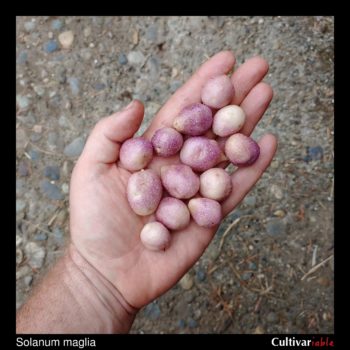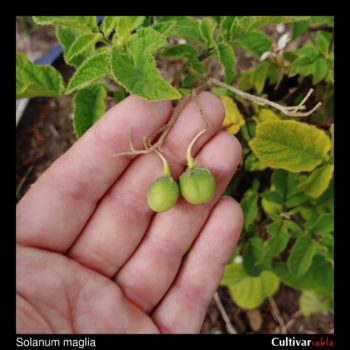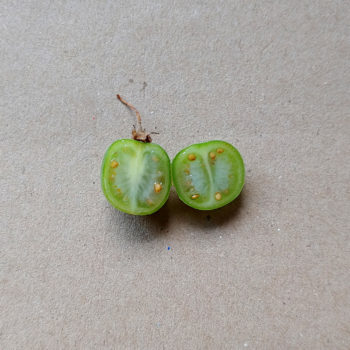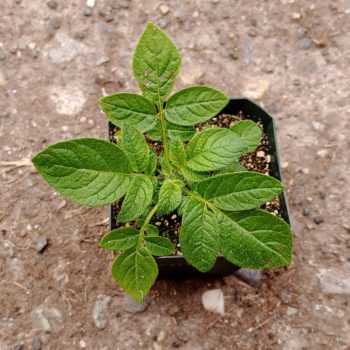No products in the cart.
Blog, potato (Solanum tuberosum)
Crossing Between Solanum maglia and Domesticated Diploid Potatoes (Part 1)

Solanum maglia is a wild potato from Chile. It is kind of an oddity, because it grows in a region of South America quite some distance from both other populations of wild potatoes and from the region where domesticated potatoes were originally grown in Chile. Unlike the vast majority of wild potatoes, it is a lowland species, growing near the coast. It is a diploid and triploid species and has A type cytoplasm, which is found almost exclusively in domesticated potatoes. Its origin has been debated, but not with any resolution. It does appear to have played some role in the development of Chilean domesticated potatoes, although it is also possible that it is an isolated, degenerate descendant of those potatoes. Isolation and frequent triploidy has left it with relatively little genetic diversity.
There isn’t much information about using this species in potato breeding that doesn’t go back to the very early days and that information is uncertain because it appears that S. maglia was commonly confused with feral domesticated potatoes. For example, Luther Burbank did some work with this species, but based on his descriptions, the potato that he was working with was almost certainly a domesticated type. This species doesn’t have any impressive disease or pest resistances, so it doesn’t seem to have attracted much attention among professional potato breeders.

Most diploid potato species, including domesticated diploids, are self-incompatible, so they can’t produce true seeds without a pollinator. Spooner (2012) noted low SSR diversity in this species, which may indicate that it is self-compatible. Unfortunately, only one diploid clone is available in the USA, and I have had no luck obtaining pollen from it. Isolated plants produced no berries. It is possible that it is self compatible but that remaining populations have become so inbred that they are no longer fertile. That means that there is little hope of obtaining true seed of this species. However, that doesn’t necessarily rule out pollination by other potato species. In fact, there are quite a lot of wild diploid species that would probably make good candidates for crossing to S. maglia. I will try some of those crosses in the future, but my first instinct is always to try crossing to domesticated potatoes to see if I can get something useful for further breeding.
My S. maglia is diploid and 2EBN. Crosses are usually possible only when two species have the same EBN (endosperm balance number). That means that a cross with tetraploid, 4EBN domesticated potato was going to have a low probability of success. It would require S. maglia to produce unreduced (2n) ovules, which is not that common in any potato species. On the other hand, diploid domesticated potatoes are also 2EBN and at least have the potential of being a straightforward cross, producing diploid progeny. Diploid crosses can work as long as the genomes of the two parents aren’t too distantly related. Usually, you would expect diploid crosses with the same nuclear genome type to work. Diploid crosses involving two genomes tend not to work out so well and can be non-viable, sterile, surviving only through spontaneous polyploidization, or broken in other interesting ways. Domesticated potatoes have the A genome and S. maglia has the… unknown genome. Well, the fact that nuclear genetic markers tend to group this with some Chilean domesticated potatoes makes me think that the A genome is a likely guess. If it has A type cytoplasm and an A genome, there is every possibility that a diploid cross would actually be fertile. Even better, if Solanum maglia is self compatible, it could potentially introduce that trait to domesticated potatoes, as has been done previously using a gene found in S. chacoense.

So, to make a long story short, I threw a lot of domesticated diploid pollen at S. maglia and hoped for the best. I pollinated the flowers once a day and got nothing, so I started pollinating them several times a day, for three weeks. Finally, I got some tiny berries. At one point, I had five berries. Then, something ate three of them. I swore, but you get used to these kinds of setbacks when breeding plants. I built a little cage to protect the two remaining berries and, after another five weeks on the plant, they were mature!
There was a big question to answer though: did these berries contain any seeds? When making crosses between potato species, you rarely get a lot of seed. In fact, quite often, you get berries that are entirely seedless. That’s always a great disappointment. Happily, S. maglia didn’t disappoint and I got a surprising 44 seeds from two berries. That suggests that the parents had pretty good compatibility. On closer examination, 12 of those seeds dried down small and malformed, probably lacking in endosperm. So, 32 apparently normal seeds. Still, that is pretty respectable for any wild potato cross.
I saved the seeds until this spring and sowed them with great anticipation. I will thrilled to get quick germination, then, not so thrilled to see the tiny seedlings sit there for several weeks with very little development. Eleven of the thirty-two seeds eventually germinated. Ten of those either never formed true leaves or just barely did before packing it in. One, slow growing seedling clung to life. This is not an auspicious result. What you hope for in an interspecies cross is heterosis, AKA “hybrid vigor.” You hope for it, but often you don’t get it. There must be an antonym for heterosis, but I don’t know what it is. Too bad, because that is a word that I would use all the time. The weak seedling growth suggests that the two parent species probably have a lot of deleterious alleles that don’t combine well, even if they set seed readily enough.

I wasn’t very optimistic. I started writing this post a few weeks ago and the moral of the story was going to be: wild species crosses don’t always work. I’m happy to report though that the one seedling that didn’t die seems to be taking a turn for the better. It was greatly outpaced by all the domesticated seedlings sown at the same time, but it has recently put on some healthy looking growth and I now think it is likely to survive and produce something this year. It is just getting big enough to note some interesting features. The leaves do appear somewhat intermediate in form between S. maglia and domesticated types and the yellow color at the base of the leaflets is interesting. If it were a domesticated seedling, I would take that as a probable sign of yellow flesh, which definitely does not exist in S. maglia. I still can’t make any useful predictions, but that is all part of the fun. This could end up a weak, sluggish, sterile plant with yard-long stolons and tubers the size of jelly beans, or it could turn out to have good fertility and an interesting combination of wild and domesticated traits. We won’t know until fall, although one of those two conditions is much more likely than the other.
You can probably guess whether or not I will attempt this cross again, after all that work for such poor results. Of course I will! I’m growing ten times as much S. maglia this year so I can produce a lot more seed. If you are involved in my participatory breeding projects, you might even get a crack at them next year.
Update! Not long after writing this, ten more seeds germinated. It appears that these seeds may be segregating for dormancy. The second group of seedlings also seems to be doing better, so I may have a chance to evaluate more than just one seedling this year.
This post continues in Part 2.
